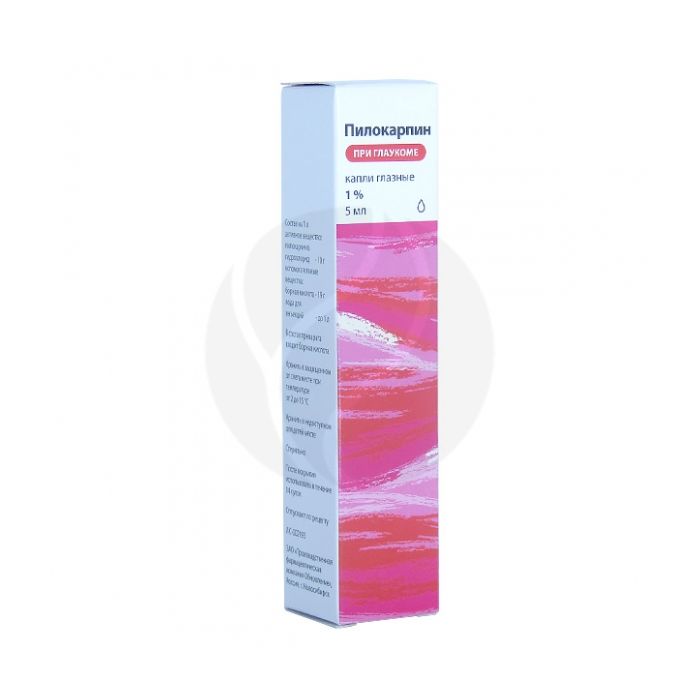Pilocarpine eye drops 1%, 5 ml
Expiration Date: 05/2027
Russian Pharmacy name:
Пилокарпин капли глазные 1%, 5 мл
Acute attack of angle-closure glaucoma, secondary glaucoma (vascular, post-traumatic), primary open-angle glaucoma (in combination with ?-blockers or other drugs that reduce intraocular pressure).
The need for constriction of the pupil after instillation of mydriatics.
Conjunctival. Primary glaucoma: 1 drop into the affected eye 2Ц6 times a day (the concentration and daily dose is determined by the doctor depending on the level of intraocular pressure).
Acute attack of angle-closure glaucoma: within 1-2 hours - every 15 minutes, 1 drop, 3-4 hours - every 30 minutes, 1 drop, 5-6 hours - one instillation per hour.
Eye drops 1% 1 ml
pilocarpine hydrochloride 10 mg
Hypersensitivity to pilocarpine;
iritis, iridocyclitis;
conditions in which miosis is undesirable (for example, after surgical intervention on the eye, except for those cases when it is necessary to narrow the pupil immediately after surgery in order to prevent the formation of synechiae);
retinal detachment (including history) and conditions predisposing to retinal detachment;
children and adolescents up to 18 years old /
With caution: in young patients with high myopia.
pharmachologic effect
M-cholinomimetic, methylimidazole derivative. Has a direct m-cholinomimetic effect. When applied topically in ophthalmology, it causes pronounced miosis, accommodation spasm and reduces intraocular pressure. The decrease in intraocular pressure is due to the contraction of the ciliary muscle and the muscle of the iris, which leads to the expansion of the angle of the anterior chamber of the eye and changes the physical structure of the trabecular network, facilitating the outflow of aqueous humor.
Pharmacokinetics
Pilocarpine penetrates well through the cornea and is well absorbed through the conjunctiva. It is practically not absorbed in the conjunctival sac. When applied topically, Cmax in the aqueous humor of the eye is achieved 30 minutes after instillation. Pilocarpine binds to many tissues of the eye. T1 / 2 from the environment of the eye is 1.5 - 2.5 hours. Pilocarpine is not metabolized in the tissues of the eye and is excreted unchanged with the intraocular fluid. It turns into an inactive form by hydrolysis in blood serum and liver. T1 / 2 from plasma is about 30 min.
Side effect
Possibly: headache, short-term pain in the eye area; myopia; decreased vision, especially at dusk, lacrimation, rhinorrhea, superficial keratitis, allergic reactions; with prolonged use - follicular conjunctivitis, contact dermatitis of the eyelids, reversible lens opacity.
Rarely: systemic reactions - bronchospasm, slowing heart rate, increased secretion of the salivary glands, rhinorrhea.
Application during pregnancy and lactation
During pregnancy and during breastfeeding, it should be used only after consulting a doctor, in cases where the intended benefit to the mother outweighs the potential risk to the fetus or infant.
Application in children
Contraindicated for use in children and adolescents under the age of 18 years.
special instructions
Treatment should be carried out with regular monitoring of intraocular pressure.
To prevent the ingress of pilocarpine into the systemic circulation, it is recommended to press with fingers on the inner corner of the eye for 1-2 minutes after instillation.
Pilocarpine is not recommended when wearing soft contact lenses.
In the presence of an initial cataract, the myotic effect can cause transient visual impairment.
Influence on the ability to drive vehicles and mechanisms
Miosis can cause disturbances in dark adaptation. After instillation of pilocarpine, care must be taken when driving at night or in poor light. At the very beginning of treatment, young patients may develop an accommodation spasm, which can lead to a decrease in visual acuity.
Drug interactions
Pilocarpine antagonists are atropine and other m-anticholinergics. With simultaneous use with adrenergic agonists, antagonism of the action may be observed.
Timolol and phenylephrine increase the decrease in intraocular pressure by decreasing the production of intraocular fluid.
It is possible to use pilocarpine in combination with sympathomimetics, ?-blockers, carbonic anhydrase inhibitors.
M-cholinomimetic activity of pilocarpine is reduced by tricyclic antidepressants, phenothiazine derivatives, chlorprothixene, clozapine; enhanced by cholinesterase inhibitors.
Perhaps the development of bradycardia and a decrease in blood pressure during general anesthesia with the use of halothane in patients using pilocarpine in eye drops.

